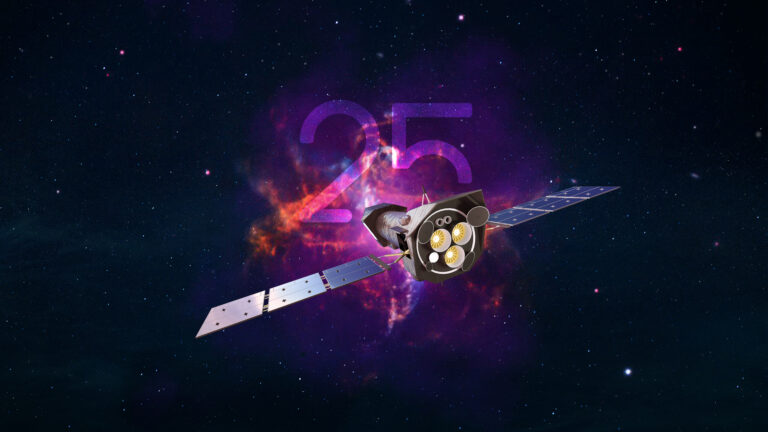On December 10th, ESA’s X-ray observatory XMM-Newton celebrates 25 years in space. SRON contributed to one of XMM-Newton’s three instruments—the Reflection Grating Spectrometer. From planets to black holes, the space telescope has delivered many ground-breaking observations of a variety of celestial objects. Let’s take a look at four fascinating discoveries from the past five years.
Jupiter’s mystery
Setting off on our journey from the Solar System, we find that XMM-Newton helped to answer a 40-year old mystery: how do X-ray auroras arise at Jupiter’s magnetic poles?
XMM’s observations combined with measurements by NASA’s Juno mission enabled astronomers to see the aurora-making mechanism at work, for the first time. As Jupiter rotates and drags its magnetic field, the field is compressed. This heats the particles trapped by the magnetic field which directs them down into the atmosphere of Jupiter, sparking the X-ray aurora.
At the edge of a gigantic black hole
In the ‘neighbourhood’ outside our home galaxy, XMM-Newton has shed light on the environments closely surrounding gigantic black holes.
ESA’s XMM-Newton and NASA’s NuSTAR space telescopes observed extremely bright flares of X-ray light coming from around a supermassive black hole. This gravitational ‘monster’ is 10 million times more massive than the Sun and lies at the centre of a spiral galaxy 800 million light-years from Earth.
The telescopes picked up X-ray flares bouncing off the gas falling into the black hole. And also, for the first time, they captured the echoes of these flares reflected by the gas in the disc behind the black hole. By looking at the delays between the primary flares and their echoes, astronomers can create a 3D-map of the black hole surroundings.
Sizing up the ‘monster’
Further out, at 1 billion light-years from Earth, researchers have used XMM-Newton to track these light echoes from the ‘corona’ of a supermassive black hole in the core of an active galaxy. The corona is the cloud of billion-degree gas surrounding the black hole and its dynamics are strongly linked to the characteristics of this gravitational monster.
By watching how light bounced off from the corona scientists were able to track how it changed over time. From this, they could determine the mass and spin of the galaxy’s central black hole with increased accuracy.
Blistering gas sloshing among galaxies
We end our trip through XMM-Newton’s recent discoveries at 240 million light-years away from Earth, in the Perseus cluster of galaxies. For the first time, XMM-Newton captured direct signs that the fiery hot gas dispersed among the galaxies is flowing and sloshing.
The Perseus Cluster is one of the most massive known objects in the Universe. It contains hundreds to thousands of galaxies and a huge amount of intergalactic gas at temperatures of around 50 million degrees that shines brightly in X-rays.
Learning more about the motions of intra-cluster gas is key to understanding how galaxy clusters form and evolve. Scientists think that these massive flows may be driven by smaller sub-clusters of galaxies colliding and merging with the main cluster itself.
Looking forward
Crucially, XMM-Newton’s observations also serve to prepare for investigations with ESA’s future large-class mission NewAthena, planned to be the largest X-ray observatory ever built.
So, happy birthday XMM-Newton! We are looking forward to many more years of exciting discoveries.



